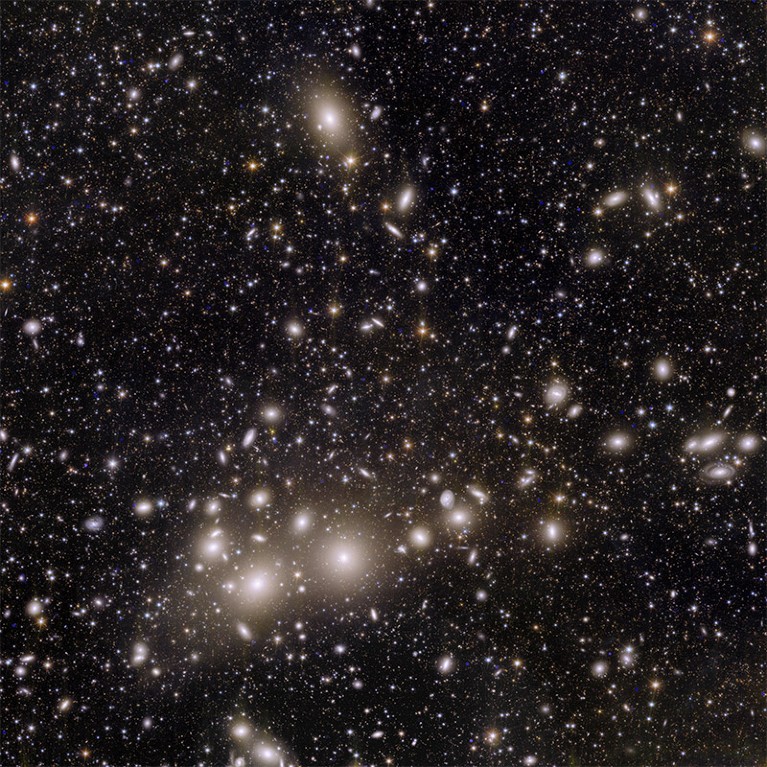The European space telescope Euclid has released its first images, offering a glimpse of distant galaxies and stars. The telescope was launched on 1 July, with the aim of mapping billions of galaxies and exploring the distribution of dark matter and dark energy.
The images include a detailed view of the spiral galaxy IC 342, which had previously been difficult to observe so clearly in one shot. “This is the first telescope which can capture in one single exposure the entire galaxy and the surroundings with this exquisite resolution,” said Francis Bernardeau, deputy lead of the Euclid Consortium at CEA Paris–Saclay, a research centre of the French Alternative Energies and Atomic Energy Commission, during an online presentation on 7 November.
The main camera on the European Space Agency (ESA) probe records visible light in black and white, but the pictures were colourized by adding information from the probe’s second camera. Astronomer Jean-Charles Cuillandre at CEA Paris–Saclay processed the raw data to produce these colour images.
“What is blue in this image is really red in real life, and what is red is infrared, so it’s invisible,” said René Laureijs, the Euclid project scientist at ESA in Noordwijk, the Netherlands, at the presentation.
The Perseus galactic cluster.Credit: ESA/Euclid/Euclid Consortium/NASA, image processing by J.-C. Cuillandre (CEA Paris-Saclay), G. Anselmi, CC BY-SA 3.0 IGO
Another of the images shows the Perseus Cluster, an assembly of more than 1,000 galaxies lying around 74 million parsecs (240 million light years) from the Milky Way. Euclid’s primary mission is to map galaxies such as these across one-third of the sky to build a 3D map of the Universe. Cosmologists will use that information to map the distribution of dark matter across the Universe, as well as the dark energy that is causing the Universe’s expansion to speed up.
“The dark matter and the dark energy, and the physics that govern those, are encoded in the shapes and the patterns we will see in these Euclid images,” ESA director of science Carole Mundell said at the presentation. Researchers will measure small deformations in the shapes of distant galaxies, produced when the gravity of galaxies in the foreground bends passing light.
Globular cluster NGC 6397.Credit: ESA/Euclid/Euclid Consortium/NASA, image processing by J.-C. Cuillandre (CEA Paris-Saclay), G. Anselmi, CC BY-SA 3.0 IGO
Euclid captured unprecedented detail on NGC 6397, a ‘globular cluster’ of stars about 2,400 parsecs (7,800 light years) from the Solar System.
“We have this enormous field of view that contains all the stars in the globular cluster, but also, at the same time, the high resolution where we resolve the single stars,” said Reiko Nakajima, a Euclid scientist at Bonn University in Germany. “The resolution is good enough that we can see background galaxies behind those stars.”
The Horsehead Nebula.Credit: ESA/Euclid/Euclid Consortium/NASA, image processing by J.-C. Cuillandre (CEA Paris-Saclay), G. Anselmi, CC BY-SA 3.0 IGO
The Horsehead Nebula, also known as Barnard 33, is a star-forming region in the belt of the constellation Orion. “What we see here is gas and dust that come from the explosions of stars that have ended their lives,” said Jason Rhodes, a Euclid scientist at NASA’s Jet Propulsion Laboratory in Pasadena, California. “That gas and dust is starting to coalesce to form new infant stars.”
